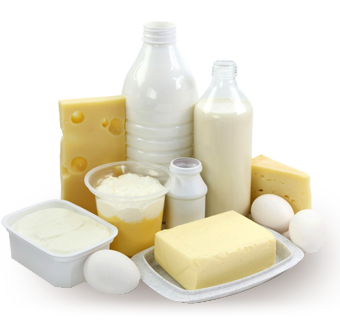
The Link Between Liver Disease and Dairy Problems
 The Link Between Liver Disease and Dairy Problems
The Link Between Liver Disease and Dairy Problems
Likely a consequence of small intestine bacterial overgrowth, many people with chronic liver disease may have difficulty digesting dairy.
We all seem to know someone who avoids eating ice cream and cheese due to lactose intolerance. However, many with liver disease unknowingly fall into the same category. Because those with liver disease (especially cirrhosis) are more susceptible to small intestine bacterial overgrowth than those with a healthy liver, they are also more likely to experience the symptoms of lactose intolerance.
About Lactose Intolerance
Lactose intolerance is when the body can’t easily digest lactose, a natural sugar found in milk and dairy products. Lactase is an enzyme normally produced in the small intestine and it is necessary to digest lactose. Without enough lactase, lactose moves through the large intestine without being properly digested. Symptoms of undigested lactose usually include:
- Flatulence or a gurgling stomach
- Stomach pain or cramps
- Bloating
- Diarrhea
- Nausea or vomiting
Lactose intolerance either begins in infancy or adulthood. Lactose intolerance in infancy is a relatively rare disorder; however, lactose intolerance that develops in adulthood is increasingly common. Approximately 65 percent of the adult population has a reduced ability to digest lactose. Lactose intolerance in adulthood is most prevalent in people who are:
- East Asian
- West African
- Arabian
- Jewish
- Greek
- Italian
The prevalence of lactose intolerance is lowest in populations with a long history of dependence on unfermented milk products as an important food source. For example, only about 5 percent of people of Northern European descent are lactose intolerant.
There are many different possible reasons that adults develop lactose intolerance. However, one of the major contributors to lactose intolerance is a microorganism imbalance in the small intestine. Such an imbalance impairs the small intestine’s cells’ ability to produce the lactase enzyme.
Small Intestine Bacteria Overgrowth (SIBO)
The entire gastrointestinal tract, including the small intestine, normally contains bacteria. SIBO occurs when abnormally large numbers of bacteria are present in the small intestine. SIBO causes symptoms similar to the signs of lactose intolerance: flatulence, bloating, abdominal pain and diarrhea or constipation.
The gastrointestinal tract is a continuous muscular tube where the digestion of food and the absorption of necessary nutrients into the bloodstream occur. Normally, the coordinated action of the muscles of the stomach and small intestine propel food from the stomach, through the small intestine and into the large intestine. This muscular action typically moves any overabundance of bacteria out of the small intestine. However, any health condition that interferes with the normal muscular activity in the small intestine allows for bacteria to overstay their welcome and multiply – potentially leading to SIBO. In addition, a lack of normal small intestine muscular activity may allow bacteria to spread backwards from the colon up to the small intestine.
One of the known consequences of a bacterial overgrowth in the small intestine is a reduction in the production of lactase. As such, SIBO and lactose intolerance frequently coexist.
Liver Problems and SIBO
A growing number of clinicians are recognizing that liver disease may increase SIBO risk, which subsequently increases the likelihood of lactose intolerance. The association has been noted in several medical journals:
- In a German study reported in the October 2001 issue of The American Journal of Gastroenterology, researchers found that 61 percent of patients with cirrhosis had SIBO.
- In a report published by Chinese researchers in the April 2010 issue of Alimentary Pharmacology and Therapeutics, the researchers reported that SIBO increases the incidence of lactose intolerance.
- In a study recently published in a March 2014 issue of the British Journal of Medicine and Medical Research, researchers found that lactose intolerance was noted in 72 percent of Italian patients with SIBO.
- In an Indian study published in a June 2009 issue of Alimentary Pharmacology & Therapeutics, researchers found that SIBO was present in about half of those with liver cirrhosis. They also concluded that the prevalence of SIBO increased with cirrhosis severity.
- In an Irish study published in a May 2011 issue of Digestive Diseases and Sciences, researchers found that SIBO was more common in people with non-alcoholic steatohepatitis (an advanced form of fatty liver disease) at nearly 78 percent than those with a healthy liver at 30 percent.
Although there are various therapeutic approaches to helping restore gut balance in those with SIBO, there are two solutions to help those with lactose intolerance:
- Avoid consumption of dairy products (such as milk, cheese, ice cream and yogurt).
- Supplement with the lactase enzyme to help break down the lactose in dairy products.
Despite its frequency, many with a chronic liver disease may not realize that their digestive discomfort could be related to SIBO and/or lactose intolerance. Learning about the role bacteria plays in the small intestine’s health and the small intestine’s responsibility to produce enzymes that break down our food will fuel awareness of digestive health. In addition, people with cirrhosis or nonalcoholic steatohepatitis may find that eliminating dairy products or taking a lactase enzyme supplement helps relieve their flatulence, abdominal pain, bloating, diarrhea and/or nausea.